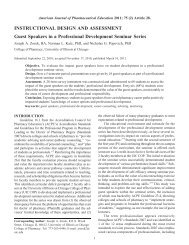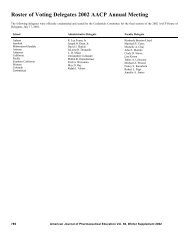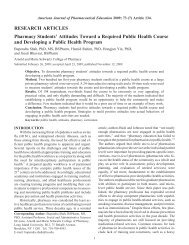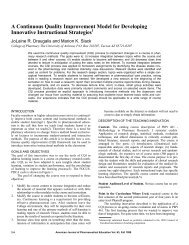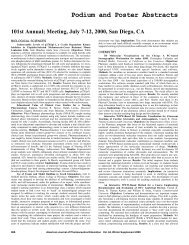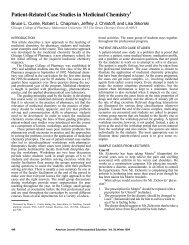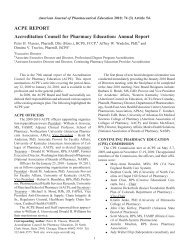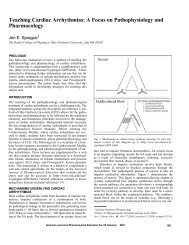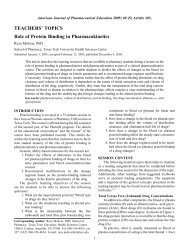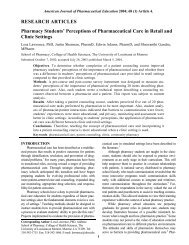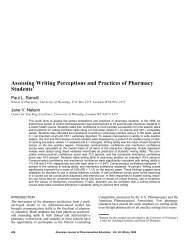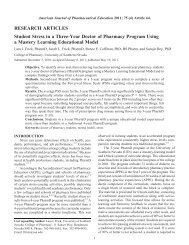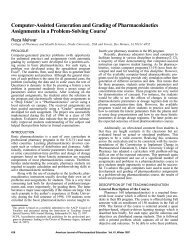View PDF - AJPE - The American Journal of Pharmaceutical Education
View PDF - AJPE - The American Journal of Pharmaceutical Education
View PDF - AJPE - The American Journal of Pharmaceutical Education
Create successful ePaper yourself
Turn your PDF publications into a flip-book with our unique Google optimized e-Paper software.
Chair Report for the Academic Affairs Committee 1<br />
J. Lyle Bootman<br />
College <strong>of</strong> Pharmacy, <strong>The</strong> University <strong>of</strong> Arizona, Tucson AZ 85721<br />
According to the Bylaws <strong>of</strong> the AACP, the Academic Affairs<br />
Committee shall consider any matter relating to the conduct <strong>of</strong><br />
pharmaceutical education to be within its purview, including but<br />
not limited to curriculum, resources, faculty, and students. <strong>The</strong><br />
committee also considers matters extending beyond pharmaceutical<br />
education to higher education, especially those elements concerned<br />
with health pr<strong>of</strong>essions education. It is the committee’s<br />
responsibility to bring to the Association’s attention for information<br />
or action those issues it identifies as timely and important.<br />
In addressing its charges, the Academic Affairs Committee<br />
focused on planning as the ideal major thrust for schools and the<br />
provision <strong>of</strong> resources and assistance to schools by AACP to<br />
facilitate the process.<br />
PLANNING AND IMPLEMENTING THE PHARMD<br />
PROGRAM<br />
Based on the committee’s general awareness <strong>of</strong> current environmental<br />
change and the status <strong>of</strong> degree programs at schools and<br />
colleges <strong>of</strong> pharmacy, the following guidelines and recommendation<br />
are <strong>of</strong>fered to assist schools and colleges with initiating change.<br />
Suggested Plan Components. A plan to effect change and<br />
implement the PharmD as the sole pr<strong>of</strong>essional degree at an<br />
institution should be developed with a global view <strong>of</strong> what the<br />
desired outcome for the school/college will be. Piecemeal change,<br />
such as redirecting the next two new hires, is inadequate and not<br />
the type <strong>of</strong> bold move necessary. <strong>The</strong> following guide, derived from<br />
the process suggested by the AACP Commission to Implement<br />
Change in <strong>Pharmaceutical</strong> <strong>Education</strong>, is <strong>of</strong>fered to assist schools in<br />
moving forward efficiently and effectively.<br />
• Build a clear understanding <strong>of</strong> the need for change among the<br />
school’s faculty.<br />
• Establish a management structure to facilitate the planning and<br />
implementation <strong>of</strong> curricular change. For example, it may be<br />
necessary to appoint an assistant or associate dean for academic<br />
affairs to coordinate all activities associated with the change<br />
process and/or to establish a strong steering or executive committee.<br />
• Establish a written timetable for planning.<br />
• Develop a statement <strong>of</strong> mission and goals that clearly outline the<br />
purposes <strong>of</strong> the school and its curriculum. Expectations must be<br />
reasonable and feasible. <strong>The</strong> school must decide if it should/can<br />
educate students for a variety <strong>of</strong> careers (e.g., practice, industry,<br />
science). <strong>The</strong> planning process must include prioritization <strong>of</strong><br />
multiple missions to drive resource allocation.<br />
• Establish a system for faculty skill development related to curriculum<br />
and instructional design. Most schools lack expertise<br />
regarding the process <strong>of</strong> curricular change (e.g., construction <strong>of</strong><br />
a mission statement, defining outcomes, teaching/learning strategies,<br />
student assessment methods).<br />
• Develop a comprehensive outcomes document that clearly describes<br />
what graduates from the program will be able to do.<br />
<strong>The</strong>se outcomes should be derived from practice functions and<br />
1 Committee members: J. Lyle Bootman (Arizona), Ronald Borchardt<br />
(Kansas), Bruce L. Currie (Midwestern), George E. Francisco (Georgia,<br />
Jean M. Nappi (MUSC). Liasion member: Robert H. Hunter (Merck<br />
Human Health Division).<br />
the mission <strong>of</strong> the school/college. Tools such as the CAPE<br />
<strong>Education</strong>al Outcomes and the practice function delineation<br />
from the Scope <strong>of</strong> Pharmacy Practice Project are available from<br />
AACP to assist faculties with this activity.<br />
• Design and plan a curriculum that will achieve the outcomes and<br />
incorporate the teaching methods described in Background Paper<br />
II. Part <strong>of</strong> the change plan should include identification <strong>of</strong><br />
how to implement multidisciplinary education throughout all<br />
four years <strong>of</strong> the pr<strong>of</strong>essional program (e.g., students from<br />
various health pr<strong>of</strong>essions are assigned to groups which function<br />
together for the four years <strong>of</strong> the educational programs).<br />
• Identify experiential learning rotations and other types <strong>of</strong> experiences<br />
(e.g., laboratories) that will be required to assist students<br />
in achieving the stated outcomes.<br />
• Identify unique strengths <strong>of</strong> the program that may contribute to<br />
pharmaceutical care.<br />
• Identify the physical and financial resources needed for program<br />
initiation through full implementation.<br />
• Identify the faculty necessary to carry out the curriculum at<br />
program initiation through full implementation.<br />
• Develop plans to obtain the resources necessary to achieve<br />
faculty approved goals.<br />
• Identify desired student attributes, determine admissions criteria,<br />
and select screening methods.<br />
• Identify the barriers that are impeding or may impede movement<br />
toward goals. Part <strong>of</strong> the school plan must include how to<br />
organize, educate, and empower the faculty. One major barrier<br />
to change is that faculty are oblivious to the changing health<br />
care environment.<br />
• Develop plans to resolve barriers.<br />
• Seek support from pharmacists in the state.<br />
• Seek support from the public (e.g., labor unions, consumer<br />
groups). Change plans as needed to include details related to<br />
marketing pharmacists/pharmaceutical care to the public.<br />
• Secure university administration and state higher education approval<br />
<strong>of</strong> the change in degree <strong>of</strong>fered.<br />
• Develop a timetable for implementing the plan.<br />
• Develop procedures and criteria to monitor and evaluate progress.<br />
• Revise plans as necessary.<br />
RECOMMENDATION 1: AACP should assist each member<br />
institution to develop a well-articulated, written plan for the implementation<br />
<strong>of</strong> change as described by the Commission to Implement<br />
Change in <strong>Pharmaceutical</strong> <strong>Education</strong> in its position paper,<br />
“Entry-level <strong>Education</strong> in Pharmacy: A Commitment to Change.”<br />
<strong>The</strong>se plans should be developed no later than January 1996 so that<br />
the 1996 Interim Meeting programs <strong>of</strong> the Council <strong>of</strong> Deans and<br />
Council <strong>of</strong> Faculties may focus on the sharing among schools <strong>of</strong><br />
their detailed change implementation plans and continued skill<br />
building necessary to implement necessary change.<br />
BEYOND THE PHARMD<br />
Over and above implementation <strong>of</strong> the PharmD as the sole pr<strong>of</strong>essional<br />
degree in pharmacy and implementation <strong>of</strong> curriculums that<br />
prepare students to provide pharmaceutical care, there are other<br />
issues at the local, state, and national levels which are impacting or<br />
will impact pharmaceutical education. <strong>The</strong> Committee urges the<br />
<strong>American</strong> <strong>Journal</strong> <strong>of</strong> <strong>Pharmaceutical</strong> <strong>Education</strong> Vol. 59, Winter Supplement 1995<br />
11S
Association and individual schools and colleges <strong>of</strong> pharmacy to<br />
begin to consider and study these environmental changes (e.g.,<br />
consolidation <strong>of</strong> industries, rapid growth <strong>of</strong> managed care, focus on<br />
total disease management, etc.) and their impacts on higher education,<br />
pharmaceutical education, and the pr<strong>of</strong>ession <strong>of</strong> pharmacy.<br />
<strong>The</strong> committee <strong>of</strong>fers the following recommendations to assist<br />
the Association and colleges assess opportunities and threats in<br />
the evolving environment and to move the academy to the next<br />
level beyond implementation <strong>of</strong> the PharmD<br />
RECOMMENDATION 2: AACP should establish a national<br />
advisory board with representation from corporate employers,<br />
insurers, politicians, practitioner organizations, etc. to provide an<br />
ongoing environmental scan and participate in dialogue about the<br />
health care and higher education environments. Input from this<br />
group should be summarized by AACP staff and distributed to the<br />
membership in the form <strong>of</strong> a two-page information summary,<br />
including external opportunities and threats to pharmaceutical<br />
education and schools and colleges <strong>of</strong> pharmacy.<br />
RECOMMENDATION 3: AACP should alter the Implementing<br />
Institutional Change program to be a deliberate effort to make the<br />
membership more comfortable with change and help faculty understand<br />
pharmaceutical care. An effort should be made to provide<br />
all schools with presenters [i.e., teams <strong>of</strong> academics and nonacademics<br />
(e.g., insurers, practitioners, industry representatives)]<br />
to deliver the “state <strong>of</strong> the environment” message.<br />
RECOMMENDATION 4: Recognizing that the lack <strong>of</strong> reliable<br />
manpower data is limiting progress toward implementing change,<br />
AACP, through its role as Secretariat for the Manpower Project,<br />
Inc., should encourage the Project to provide a more sophisticated<br />
analysis <strong>of</strong> workforce patterns under the new paradigm <strong>of</strong> health<br />
and pharmaceutical care delivery.<br />
RECOMMENDATION 5: <strong>The</strong> AACP Student Services Personnel<br />
SIG should convene a task force to delineate desired attributes<br />
<strong>of</strong> incoming pharmacy students, in light <strong>of</strong> future practice roles and<br />
realities for pharmacists, for the purposes <strong>of</strong> designing screening<br />
criteria and methods to use in the admissions process.<br />
RECOMMENDATION 6: <strong>The</strong> AACP Council <strong>of</strong> eans should<br />
convene a task force to identify approaches to funding pr<strong>of</strong>essional<br />
degree programs, including potential partnerships within academic<br />
health centers and within the managed care environment.<br />
<strong>The</strong> Committee felt that the background considerations and<br />
activities described in Recommendations 2 through 6 were necessary<br />
before President Knapp’s second charge could be adequately<br />
addressed. Once a better understanding <strong>of</strong> the new economic and<br />
practice environments is gained, a future Academic Affairs Committee<br />
should consider environmental changes and challenges not<br />
fully addressed by the adoption <strong>of</strong> the PharmD as the sole pr<strong>of</strong>essional<br />
degree and what specific changes must be initiated by<br />
schools and colleges <strong>of</strong> pharmacy to address these challenges.<br />
RECOMMENDATION 7: A future (1995/96 or 1996/97) AACP<br />
Academic Affairs Committee should be charged to determine<br />
what alterations in curriculum, school structure and organization,<br />
financing, and external relationships will best prepare schools and<br />
colleges <strong>of</strong> pharmacy to prepare, adapt, and prosper within the<br />
evolving economic and practice environment.<br />
Am. J. Pharm. Educ., 59, 11S-12S(1995); received 8/14/95.<br />
References<br />
(1) Commision to Implement Change in Pharmacy education, “Entrylevel<br />
education in Pharmacy: A commitment to change,” Am. J.<br />
Pharm. Educ., 56, 366-374(1993).<br />
.<br />
12S <strong>American</strong> <strong>Journal</strong> <strong>of</strong> <strong>Pharmaceutical</strong> <strong>Education</strong> Vol. 59, Winter Supplement 1995



